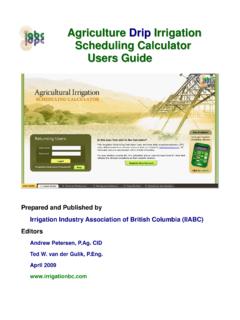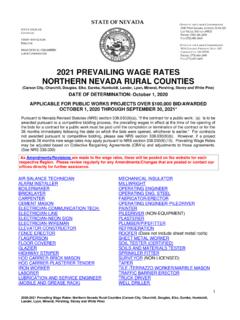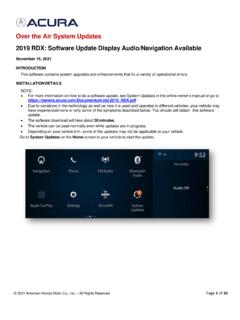Transcription of STANDARDS FOR LANDSCAPE IRRIGATION SYSTEMS
1 STANDARDS FOR LANDSCAPE IRRIGATION SYSTEMS JANUARY 2008 EDITION TABLE OF CONTENTS Introduction .. page 1 General 1. Scope of Work .. page 2 2. Quality Assurance .. page 2 3. Submittals .. page 3 4. Site Conditions .. page 3 5. Owner or Representative .. page 4 6. Regulations .. page 4 7. Alternate Materials .. page 4 Design 1. Sprinklers .. page 5 2. Pipe .. page 5 3. Zoning .. page 6 4. Controls .. page 6 5. Pressure control .. page 6 6. Winterizing .. page 7 7. Low Volume / Micro IRRIGATION .. page 7 8. control Wire .. page 7 Materials 1. Sprinklers .. page 8 2. control Valves .. page 8 3. Isolation Valves .. page 8 4. Controllers .. page 8 5. Wire .. page 9 6. Backflow Prevention Devices .. page 9 7. Pipe Polyethylene .. page 9 8. Pipe - Poly Vinyl Chloride .. page 9 9. Fittings .. page 10 10. Cement and Primer .. page 10 11. Valve Boxes .. page 10 12. Sleeving.
2 Page 10 13. Hydraulic Controls .. page 10 Installation 1. Excavation and Backfill .. page 11 2. Pipe .. page 11 3. Valves and Valve Boxes .. page 12 4. Sprinklers .. page 12 5. Wire .. page 13 6. Backflow Prevention .. page 13 7. Controller .. page 13 8. Turf Valves / Quick Coupling Valves .. page 14 9. Sleeving .. page 14 Site Maintenance .. page 15 Inspection and Testing 1. Inspection .. page 16 2. Testing .. page 16 3. Deficiencies .. page 16 Installation Detail Drawings Figure 1 Shrub Spray on Riser .. page 17 Figure 2 Turf Rotary Head or Pop Up Spray Head ..page 18 Figure 3 Quick Coupler Valve .. page 19 Figure 4 Globe Valve - Standard Installation .. page 20 Figure 5 Controller Wall Mount .. page 21 Figure 6 Residential Point of Connection .. page 22 Figure 7 As-Built Plans Minimum Recommendations .. page 23 IRRIGATION Industry Association of British Columbia 1 STANDARDS for LANDSCAPE IRRIGATION SYSTEMS INTRODUCTION The following STANDARDS for LANDSCAPE IRRIGATION SYSTEMS replace the previous publication of March 1997.
3 They have been developed by the IRRIGATION Industry Association of British Columbia to reflect the current minimum STANDARDS for the industry and to provide guidance to its members as a benchmark for their performance. The principles embodied in these STANDARDS apply to all LANDSCAPE IRRIGATION SYSTEMS but the special circumstances of some owners or installations may require the development of more customized specifications related to the project. The use of these STANDARDS is intended to encourage efficient and responsible water management and result in IRRIGATION SYSTEMS that are economical, practical, and sustainable. Owners, designers, and installers of these SYSTEMS are responsible for the use of a precious and finite resource to maintain healthy and functional landscapes. Accepted industry practice reflects these goals. The IRRIGATION Industry Association of British Columbia accepts no liability arising from the use of these STANDARDS in contractual relationships between parties to an IRRIGATION project.
4 IRRIGATION Industry Association of British Columbia 2 STANDARDS for LANDSCAPE IRRIGATION SYSTEMS GENERAL 1. Scope of Work (a) Supply and install the components required for an automatic IRRIGATION system to provide supplemental water to the intended LANDSCAPE efficiently and uniformly. (b) Obtain or prepare a scaled design of the proposed IRRIGATION system which meets IIABC Design STANDARDS . (c) Obtain properly informed agreement from the owner's representative as to the inclusion or not of desirable features in the design which exceed IIABC Design STANDARDS and/or are site specific. 2. Quality Assurance (a) All IRRIGATION work shall be done by a suitably experienced and qualified IRRIGATION contractor, having trained and competent personnel adequate for the scope of work. Utilizing Staff certified by the IIABC in such disciplines as Certified IRRIGATION Technician (level 1 or 2), Certified Designer (Commercial or Residential), Certified IRRIGATION Auditor, etc.
5 Are recommended. (b) The contractor shall be a member in good standing of the IRRIGATION Industry Association of and have met the qualification STANDARDS currently applied to contractors by that organization. (c) A written guarantee of the installed system shall be provided to the owner covering workmanship and materials for a minimum of one year. IRRIGATION Industry Association of British Columbia 3 STANDARDS for LANDSCAPE IRRIGATION SYSTEMS 3. Submittals (a) A suitably scaled as built drawing shall be provided. All components of the IRRIGATION system shall be shown as installed, with clear measurements from an identifiable reference point to the location of the controller and its circuit breaker, master valve, zone control valves, main water connection, blow out connection, pump and its electrical connections, and any other similar features. Please see Figure 7 for details.
6 (b) Provide a manual containing operating and maintenance instructions for all components of the system including but not limited to a zone map or list of zones and the areas they cover. (c) Provide clear instructions for operating the IRRIGATION system " in season , showing the relative timing differences between zones of different precipitation rates, and a schedule of run times suggested for various weather conditions. Division of the system into Hydrozones , or areas with different water requirements, whether based on gardens/grass, sun exposure, drainage patterns, or distinct areas is encouraged. (d) Provide any special tools as provided by the manufacturer for day to day servicing of the IRRIGATION equipment installed. (e) Provide a base IRRIGATION schedule indicating when and how much to irrigate, by zone, for the system installed. Indicate a source of local evapotranspiration data with clear instructions on how to alter the schedule reflecting changing ET values appropriately.
7 4. Site Conditions (a) Verify and mark the location of all on site utilities required by the IRRIGATION system. (b) Verify and mark the location of all buried cables, conduits, pipes, etc., prior to any trenching. (c) Adjust the design as necessary, together with the owner's representative, to suit existing site conditions and grades before proceeding with the work. (d) Protect from damage as necessary, existing LANDSCAPE features, plant material structures, this work in progress, and the work of other trades. (e) Ensure that sequencing of this work is carried out in coordination with the work of other trades and that sleeves are installed when appropriate. IRRIGATION Industry Association of British Columbia 4 STANDARDS for LANDSCAPE IRRIGATION SYSTEMS 5. Owner or Representative (a) Prior to commencement of any involvement with an IRRIGATION project, identify the person or persons properly authorized to make project decisions.
8 6. Regulations (a) Obtain all permits and licenses applicable to the work to be done. (b) Ensure that there is compliance with the relevant codes and regulations both in the design and during the conduct of the work involved in the project. 7. Alternate Materials (a) The formal approval of the owner's representative is required prior to the use of materials that are different from those shown in the design. (b) Alternate materials must match the original materials in performance, flow, pressure loss, and other important characteristics so as not to compromise the intent of the design. (c) The materials must all remain compatible. When changing from one product to another the flow from all the sprinklers must be recalculated to confirm pipe is still sized at 5 ft/sec. (d) The alternate materials proposed must be applied according to their manufacturer s recommendations. IRRIGATION Industry Association of British Columbia 5 STANDARDS for LANDSCAPE IRRIGATION SYSTEMS DESIGN An IRRIGATION system must apply a consistent, even, measurable amount of water to the LANDSCAPE over a period of time.
9 It is necessary that the system design consider water cost and conservation, long term durability and maintenance cost, safety issues, aesthetic issues, and site specific requirements. The relative importance of these considerations will vary from project to project and require the attention of a qualified and experienced designer. An IIABC Certified Designer of the appropriate discipline is recommended. The design will incorporate the following: 1. Sprinklers (a) The maximum spacing shall be equal to the radius of throw (head to head) with appropriate allowance for wind if applicable. (b) The selection of pop-up or riser style sprinklers must consider safety, maintenance, risk of vandalism, and appearance on the site. (c) Pop-up or riser height must consider the related plant material, its growth potential, interfering LANDSCAPE features, and arrive at a solution which provides optimum coverage for as long as possible. (d) All sprinklers must be suitably adjustable and located so as to keep the water within the landscaped area and minimize overthrow.
10 (e) Sprinklers with built in check valves must be used when low head drainage is apparent to eliminate wasted water and reduce erosion. (f) Sports fields and public parks shall be equipped with sprinklers with rubber covers in turf areas. (g) Pressure compensating devices (heads, screens, or valves) are recommended to increase efficiency and water conservation. 2. Pipe (a) The velocity of flow in piping must not exceed 5 feet per second. (b) Pipe routing must take site elevation changes into consideration to minimize low head drainage. (c) Selection of the strength and / or flexibility of the pipe material and its installation criteria must consider site specific requirements such as frost, traffic, soil depth, soil composition, soil quality, etc. (d) Pipe sizing and routing must include pressure loss calculations to ensure that the required pressure will be delivered under all circumstances and that pressure variation within the lateral is at a minimum.



